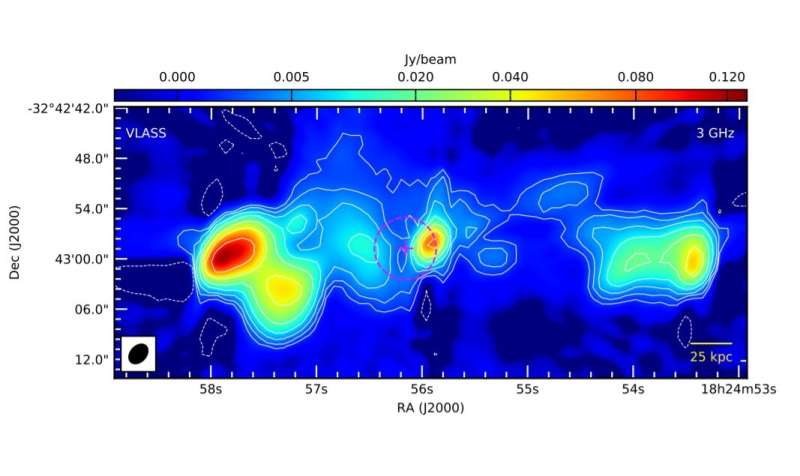VLASS image of IGR J18249-3243. Credit: Bruni et al., 2022.
Astronomers report the detection of a new Fanaroff-Riley Class II (FRII) radio galaxy using various telescopes.The newly found galaxy turns out to be a peculiar gamma-ray emitting source. The discovery was detailed in a paper published March 2 on the arXiv pre-print repository.
Radio galaxies emit huge amounts of radio waves from their central cores. Black holes at the centers of these galaxies accrete gas and dust, generating high-energy jets visible in radio wavelengths, which accelerate electrically charged particles to high velocities. Depending on the lack or the presence of hotspots on the edges of their jets, astronomers divide radio galaxies into two classes, known as Fanaroff and Riley Class I (FRI), and Class II (FRII).
IGR J18249-3243 was first detected in 2006 by the INTErnational Gamma-Ray Astrophysics Laboratory (INTEGRAL) spacecraft as an active galactic nuclei (AGN). It was initially associated with a poorly studied radio source known as PKS 1821-327. Previous observations of IGR J18249-3243 have found that it has a redshift of 0.355, is radio loud, has a complex radio morphology and a steep radio spectrum, confirming at the same time the AGN nature of the system.
Now, new study published by a team of astronomers led by Gabriele Bruni of the National Institute of Astrophysics in Rome, Italy, reports that IGR J18249-3243 emits high-energy gamma-ray (at GeV energies) and its properties suggest that it should be classified as an FRII radio galaxy.
"In this work, we present the reclassification of a Fermi-LAT source as a new FRII radio galaxy from the INTEGRAL sample found to emit at GeV energies," the researchers wrote in the paper.
IGR J18249-3243 was detected by Bruni's team at GeV energies using NASA's Fermi gamma-ray space telescope. Previous radio data show that the source is composed of at least three radio components, which all together present the typical morphology of a radio galaxy, with a central core and two lobes. It was noted that the surface brightness of IGR J18249-3243, larger for the lobes and slightly dimmer for the core, is suggestive of the FRII class.
The astronomers assume that the detected gamma-ray emission could mainly originate in the lobes by inverse Compton scattering of radio-emitting electrons off the ambient photon fields. They added that jet contribution is not sufficient to reproduce the observed GeV emission.
The researchers noted that the double-lobed structure IGR J18249-3243 was missed until now due to the lack of resolution in classical radio surveys. Therefore, the discovery that this source is an FRII radio galaxy raises the question of how many such objects are still hiddenamong the general population of GeV emitters.
"We foresee that further GeV emitting radio galaxies will be found thanks to new radio surveys, providing a deeper and sharper view on the counterparts of the GeV sky," the authors of the paper concluded.
More information: IGR J18249-3243: a new GeV-emitting FR II and the emerging population of high energy radio galaxies, arXiv:2203.01450 [astro-ph.HE] arxiv.org/abs/2203.01450
© 2022 Science X Network
























